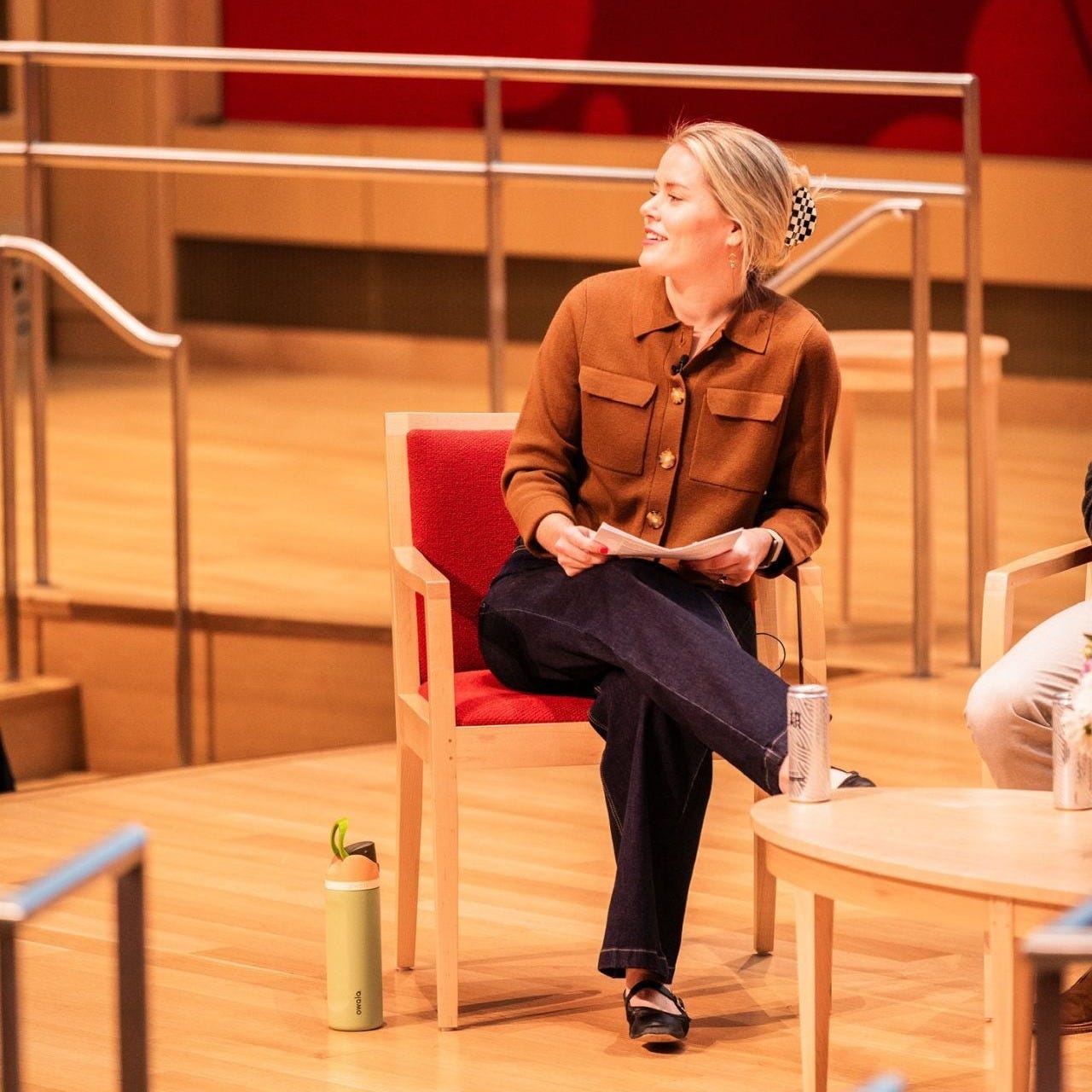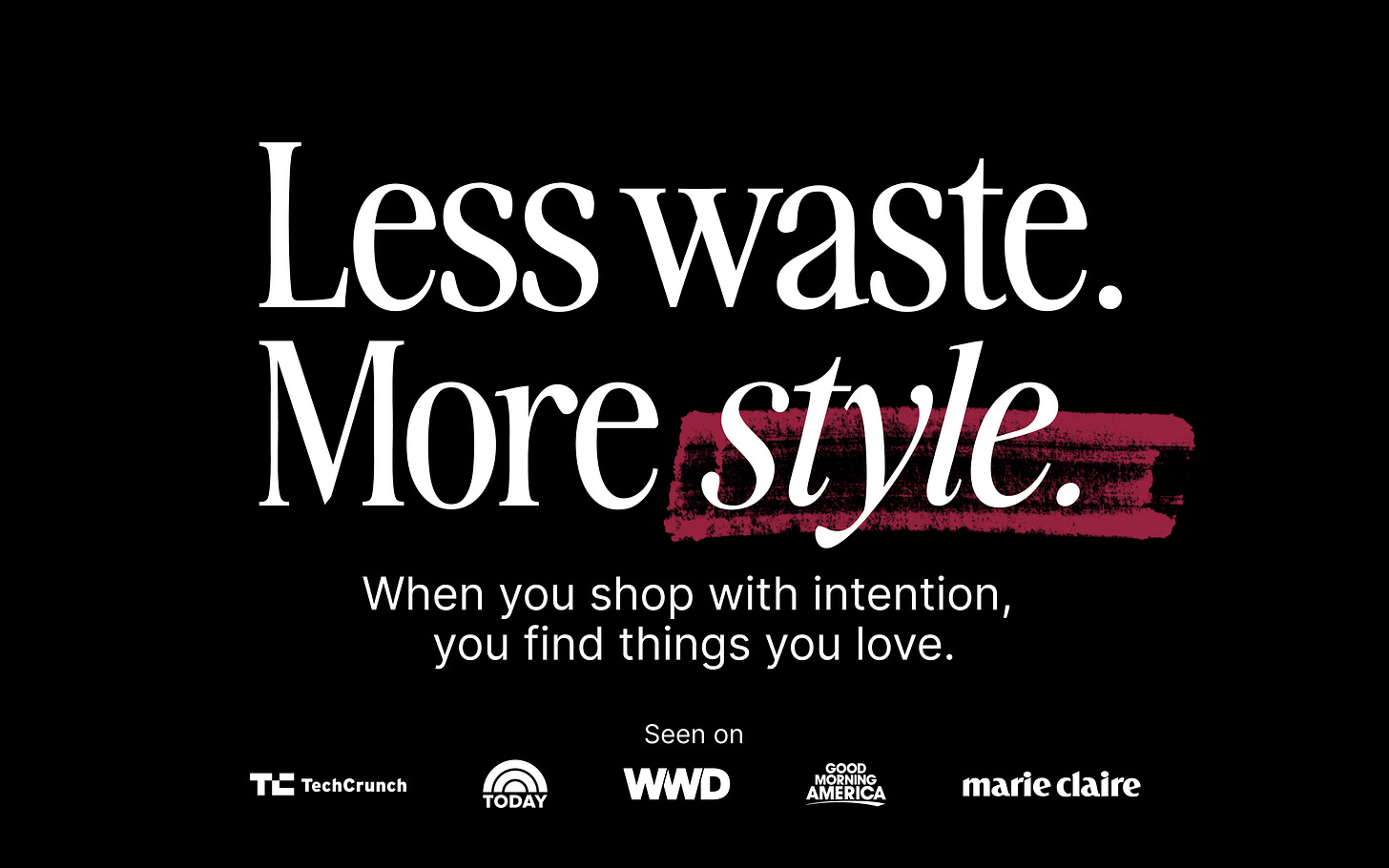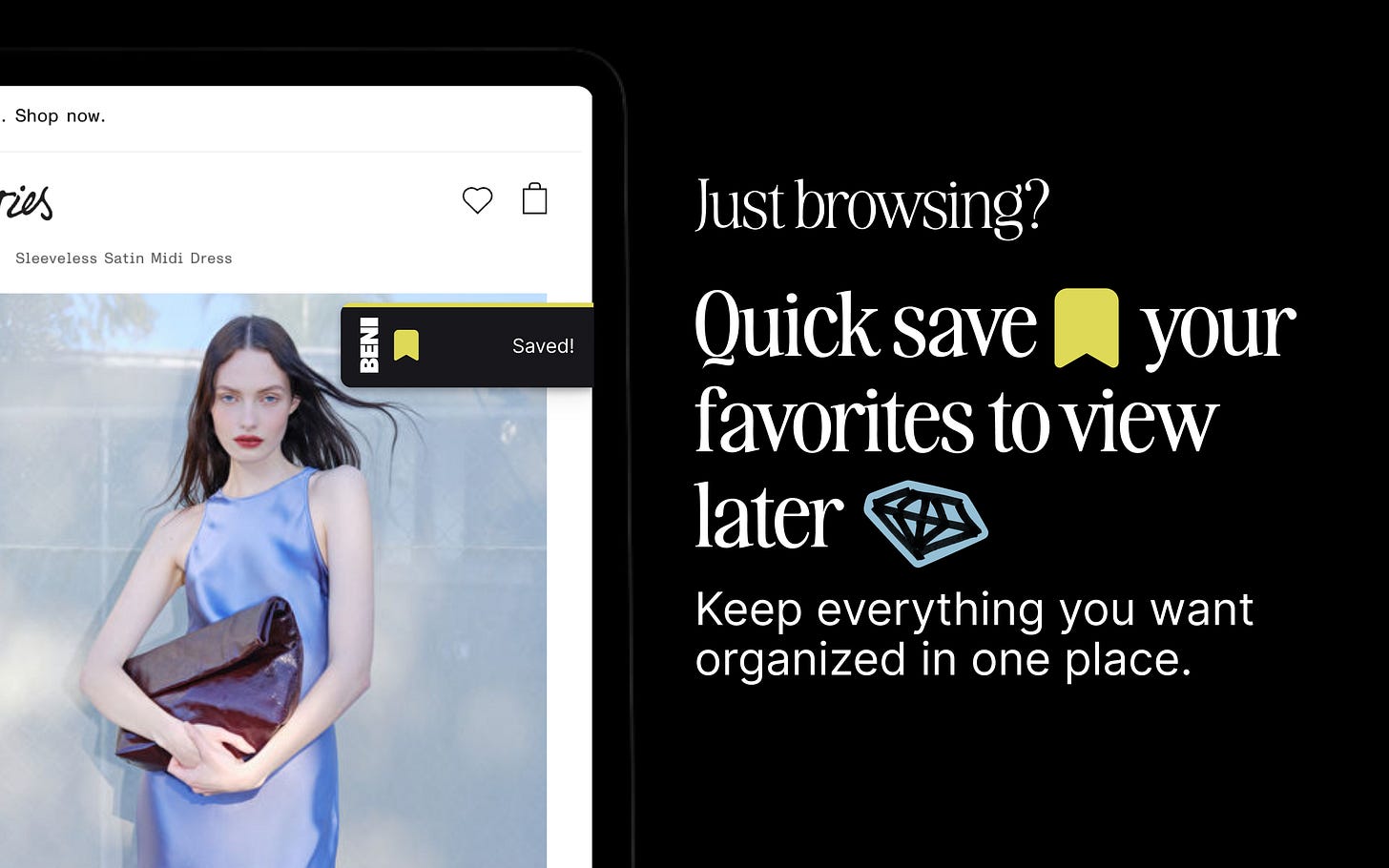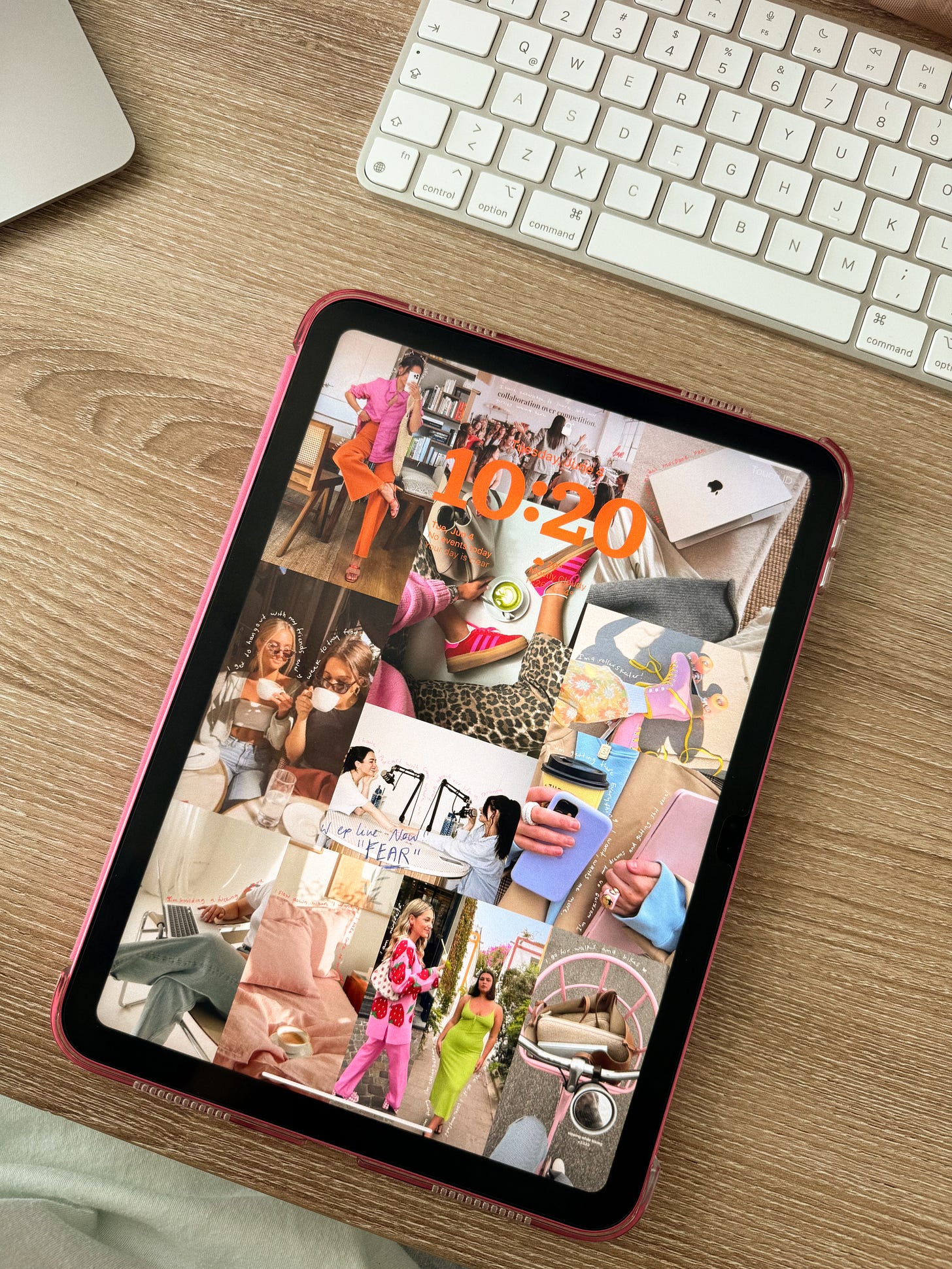Breaking Our'Add-to-Cart' Mentality
a conversation with Kate Sanner, Co-Founder & CEO at Beni, about making secondhand fashion irresistible.
Expert insights and deep dives into what works (and what doesn’t!) in circular fashion, delivered right to your inbox. I’m Emily Stochl and this is Pre-Loved 🎤 an indie media platform about all things secondhand!
Please become a paid subscriber today. I cannot sustainably produce Pre-Loved without your financial support:
On Thursday, Beni — the secondhand shopping sidekick that helps you find any item pre-loved — went dark.
We’re talking website locked, Instagram wiped to zero posts — Taylor Swift Reputation style. Picture me, repeatedly and curiously refreshing my feed with my scrolling thumb… so, I thought to myself, why don’t you just call Kate up? The Pre-Loved readers have got to know what’s going on here!
Since 2020, Beni's mission has centered around a deceptively simple idea: make secondhand shopping just as easy as buying new. For four years, the team has built technology to search hundreds of resale sites simultaneously, helping people shop smarter and (hopefully!) waste less.
But since stepping into the role of CEO, Kate Sanner has been wrestling with deeper questions about purpose. As she recently wrote in
: “if we keep clicking add to cart—even if it’s preloved, even if it’s “sustainable”—without asking why we’re buying in the first place, we’re not actually changing the system. We’re just dressing it up in thrifted denim and calling it progress.”Interrogating your fashion-tech company's purpose as a VC-backed startup could be a risky move. It’s certainly safer and easier to follow the traditional path to monetization: selling ad placements, bombarding users with push notifications, and driving your audience to chase the latest hot trends. But what does that achieve? Are we actually changing the game, or our closets?
Today’s shoppers are anxious about the economy, exhausted by the relentless trend cycle, and so-over drowning in stuff, while still struggling to find personal style. Rather than funneling more unnecessary items into our shopping carts, Beni is taking a bold step back to reimagine what intentional fashion could look like.
They hope to challenge industry norms and start crucial conversations about how we consume clothing.
So, in today’s letter, I talked to
, the Co-Founder & CEO at Beni. I asked her about the problems with traditional e-commerce “add-to-cart” models, how we develop new pathways for more intentional shopping, and how Beni is revolutionizing the secondhand buying experience.…Welcome to “Making Circularity Irresistible” 🎤 with Kate Sanner:
Kate, Beni just went dark! What’s going on?!
We want to start some conversations with this relaunch! We’re really looking to challenge what is happening in the industry right now. Can I read you something to set the context? We’re calling it the “Beni Manifesto…”
I might have you close your eyes. Let’s go:
“Shopping is broken. We live in an age of limitless choice. More brands, more drops, more trends, more ads screaming for our attention. We're drowning in stuff, yet somehow we've never felt less satisfied. Our closets are stuffed, our wallets are drained, our personal style lost in the noise.
Fashion used to be about self-expression. Now it's just another algorithmic loop pushing us to buy more, scroll more, regret more. Impulse replaces intention. Trends replace taste.
And the industry is designed to keep it this way—keep us scrolling, clicking, buying the next thing before we've even worn the last. But what if shopping wasn't about more? What if it was about better?
At Beni, we're not here to sell you more stuff. We're here to help you find what's worth it: the timeless pieces, the hidden gems—the ones that fill your life, not just your cart.
We help you save, search, and shop smarter. Not for the algorithm. Not for the ads. For you. Because when you shop with intention, you find things you love. When you shop with patience, you find the best deal. When you shop with Beni, you shop for the long haul. Fewer impulse buys. More iconic finds. Less waste. More style.
This is the future of shopping, where every purchase feels like a win. It’s time to stop chasing and start choosing.
Welcome to Beni.”
Oh my gosh, I’m really into this. What prompted this manifesto?
There's this overwhelming cultural conversation happening right now — we've hit a tipping point where it's not just about sustainability from a climate perspective. Are the ways we are consuming even emotionally-sustainable? Financially-sustainable?
We're overwhelmed with stuff and decisions. It takes up so much headspace, and we buy all this stuff, and then our closets are overwhelmed. We have piles of stuff sitting in the corner that we're supposed to get rid of, but we don't know how to get rid of it. And then that's just another thing on the to-do list — or I go drop it off somewhere, and then I feel guilty.
And it's just like this crazy cycle that we're in.
I think people are like: this isn't working for me. Like we have more stuff and less style than ever before. What's the path forward?
We don't have all the solutions at Beni, but we're working on tools to help people.
“Are the ways we are consuming even emotionally-sustainable? Financially-sustainable?”
You took over as CEO last year. How did this all start to come up for you?
I’ve been on a journey. At first, I was really focused on ‘how do we make secondhand easy?’ And I think that is an important piece of it, right? Like, how do we make sense of the world of secondhand? How do we help people find things?
But at the heart, the bigger thing is like, how do we help people shop more intentionally? And slow down and think about what they actually need and what's going to fit their lifestyle? And then, when they know what they want, and what they need, we can show them that resale is this amazing tool to help them find the highest quality at the lowest price, and to access cooler, different things that don't have to be “on trend” in the one moment.
They can just fit your style because we have the whole history of style to choose from.
Just making secondhand easier isn't solving the problem. It's just creating another category of stuff. How do we use secondhand to get to the heart of the problem? Which is that we have to slow down, and buy things we really love, and that we're going to cherish. I think there are so many rich conversations to start here.
What is it going to look like when you relaunch?
We're rebranding to say: “it pays to wait.” So in the app you can find the look when you're on the go, and quick save items. And then when you're ready to buy later, let us check the world of resale for you before you purchase. If you have patience, you will find a better deal.
Also if you have patience, you might realize — when you sat on it for 48 hours — you didn't actually want it to begin with. You're saving the hassle of getting something you don't need, and having to return it.
There's very few times when you need something "right this second." So, if you don't need it "right this second," then just save it, reference it later, and you'll be able to find it — but let us search resale on your behalf.
“Just making secondhand easier isn't solving the problem. It's just creating another category of stuff.”
Obviously this isn't something you came to overnight. What was the thought process like?
I think the biggest thing is that we're trying to solve this big problem. But we're also a VC-backed company, so what's natural to happen is the pressure to make money.
And the fastest way to make money? You sell ad placements. We have this platform, we have some amount of influence, we're trying to get people to buy secondhand. But it's such an easy, traditional trap to fall into to be like: okay, great, we'll sell these ad placements and we'll just hit people with emails and with push notifications and be like, ‘here's the must-have things for spring.’
But actually the most important thing for us at this stage is to build trust with shoppers. And that trust is going to pay dividends over time. There's lots of ways you can monetize business models, if you have a dedicated following of people. But the way to build that trust is not to funnel more things that people don't need, right?
You’re just funneling them dissatisfaction!
Right, like, I want to measure our success, not by how much you buy, but on how satisfied you are with your purchases. In order to do that, you have to acknowledge — which is uncomfortable when you're trying to make money — but you have to acknowledge that oftentimes the right decision for someone is you shouldn't buy that thing right now, or at all.
So much of entrepreneurship is about like, how do we remove as much friction as possible to the buying experience, right? Like Amazon one-click, and TikTok Shop — boom! you don't even have to think about it. You can literally scan your face and it's bought on your behalf, and shipping to you in 30 minutes.
With fashion, it should be totally different. Your style is so personal, and it should be an intentional decision, not something you offload.
So you had to build something inherently different from how the ecommerce funnel is set up to work?
Yeah, there's these really easy traps to fall into around how e-commerce works: we're gonna make it as seamless as possible, and as fast as possible, and we're gonna monetize through ads.
We started to go down some of those paths, and play it out into the future. And we were like, this isn't solving any problems and it's not going to change the industry. It's not going to materially make fashion more sustainable. It's just creating another version of the same thing.
I've been sitting with that for a while. And we said, let's take a step back, and dream about what a different path would be.
Resale is uniquely positioned as a tool to unlock some of these different opportunities because you have the whole world of inventory available to you. You're untethered from the trends, or from moving the inventory that's most current.
The challenge we're solving is not how do we move this inventory that was just created, it's how do we find better homes for the things that already exist? And that's a totally different problem.
I don't need to get you to buy more and more stuff. I need you to become really efficient at understanding who you are and what's the right match for you in this sea of inventory to be satisfied. Before you go buy something new.
“Resale is uniquely positioned as a tool to unlock some of these different opportunities because you have the whole world of inventory available to you.”
That’s a big problem to solve in itself!
Yes, now how do I intercept you, and pull from the 300 million secondhand listings that already exist, and get you what you want, rather than you going and buying something new?
Even though there's a lot of pressure to make money, we thought, let's sell our investors that the longer term vision is to not fall down these same traps, and to rethink the model entirely. That is a bigger, bolder mission! But, I think, one that's more interesting and more game changing.
Breaking that ‘add to cart’ mentality is not easy problem to solve!
What I'm really focused on is: how do we create a sustainable business that actually solves the problem, and not fall prey to how it's "always been done," and how it continues to be done.
One of the things we see a lot in the world of marketing is the funnel, right? You launch these awareness campaigns and people become aware of your product. Then they spend time considering whether they want to buy it. Then, if you hit them in the right moment, maybe they come back and purchase.
But, in the world of new media, there is no “consideration window.” You can go from awareness to conversion in 10 seconds.
You want people to save it first, then decide if it works in your wardrobe, and then find it secondhand.
One of the reasons I think this quick-save functionality is so powerful is — the reason you buy so fast is trends move fast! — you're like, if I don't buy it now, I might miss it.
Or, almost worse, ‘I gotta buy it now, but I can always return it!’ We kind of kid ourselves into that as the way of consumption. But, I think you could get that same dopamine hit by saying ‘ooh, I'm gonna save it to my moodboard.’ Now you have the opportunity to go get it later if you want it. You don't need to buy it right now. Maybe you forget about it, maybe you realize you don't need it.
Or maybe two weeks later, you're still thinking about it! So then, you go to those Beni saves, and you let Beni find you the best place to get it secondhand. I think it ends up leading to a lot more intentional decision-making.
“Let's take a step back, and dream about what a different path would be.”
What feedback are you hoping to get out of this relaunch?
First and foremost, we want to know: is this easy? Is it convenient? We don't want to disrupt you — we want to be the sidekick friend, where you're pulling something off the rack and asking them 'hey, set this aside for me.'
Once you're in your Beni collections, we can help you understand is this find good-quality? Is this actually worth it? Is it going to fit? How's it gonna fit? Does this match with other things you already own? Other things you've liked and saved?
We're gonna do a lot of listening around the product experience. Does this feel like having a stylist in your pocket? Is this super intuitive? Easy to use?
What have been like the difficult parts to figure out?
The biggest challenge we've had over the last four years is that — while this idea may feel simple, the technology to power it is really complicated. 300 million listings! And they're changing over millions every week — things are listed, things are sold. And all of that inventory is one-of-one. There's no SKU-numbers in resale, because — even if it's the same tangible item — the trust in the seller is different, or one's authenticated, or one is lightly worn and one's new with tags.
And — as you're super aware! — it's not always nicely merchandised, like with product imagery. The image might be in a dark room, or a weird background. Or it's a brand stock image, but then the item is actually not new-with-tags.
There's all this nuance in resale that makes it really complicated to make sense of them. So how does Beni ingest it all, normalize the data, make sense of it… and do that all so that your experience feels really seamless — in a matter of seconds.
That is — as you know — a giant undertaking. But, what's really cool is, we've mastered making sense of the listings. Now we're on the other side, getting more contextual understanding of the shoppers, so we can pair those two things together.
Ultimately, the more you use Beni, the smarter it gets on what's a relevant secondhand option for you. You start building your dream secondhand shop, and everyone's looks really different — as it should — because style is so personal.
As I look to the future, we're building an experience akin to walking into a thrift shop where everything's in your size, filtered in good condition, curated to your style, organized by your needs. Where someone can help give you advice, and also learn what you're looking for in the future, and pull those things. So, next time you come back, there's another rack of cool stuff for you.
It seems like you don't have to sell people on ‘choosing secondhand’ anymore, like when you started Beni.
I don't know that we could have started here. Absolutely, I think the stigma around secondhand has largely gone away. The bigger barrier now is the experience of shopping secondhand.
And so as we solve for the experience, by building a shopping experience — that I think is really cool — using all secondhand inventory! Like, this would be a novel experience even with new inventory, all the ways you're able to curate your own thing.
But you couldn't really do this with all new listings, because you'd spend all your time curating things that become full of dead-links. That's why Pinterest struggles to own shopping because dead-links are such a huge issue — and an accelerating issue as trends move so quickly and things are shopped so quickly.
But, with resale and with the image search, it's like anything you save — whether it's a new listing, a secondhand listing, an image of someone cool you saw walking down the street, a screenshot of a friend wearing a fun jacket — all of those things are endlessly searchable.
We use that image and say: go to the 300 million listings and pull the things that are similar to this. So, yeah, I think to your point, it's like, it's a novel, better shopping experience for any shopper. It just happens to be powered by resale.
I love that like, we don't have to lead with: ‘shop secondhand, it’s more sustainable.’ It's actually like, no, if you want to find your style, if you want the coolest stuff, if you want the best deals, here's where you can get it. It's secondhand.
“It's a novel, better shopping experience for any shopper. It just happens to be powered by resale.”
People accept secondhand product now — it’s desirable — but the secondhand shopping experience maybe hasn’t advanced?
Yes! People are more than happy with what they get, but is the shopping experience convenient and joyful?
When the shopping experience is enjoyable, secondhand becomes the natural choice. We've seen when you make it really easy, it becomes obvious, right? When you're looking at something new for $350, or new-with-tags at the RealReal for $130? Nine-out-of-ten people are gonna choose the RealReal there.
When you factor in time spent, or the energy it takes to find something, that calculus changes. So, I think, the easier and more fun and more joyful you can make the experience — the more irresistible secondhand becomes.
My favorite feedback is like, oh my God, you've made it so easy that buying new is ridiculous!
How can people try out the new Beni?
Visit shopbeni.com (I got you an referral link!) to be the first to unlock Beni and try out the new features. Check out all the new updates (rolling out over the next few weeks), and do let the team at Beni know any feedback!
Thanks for reading Pre-Loved! You can find me across the internet on Instagram, TikTok, and Threads! 💛 - Emily
Want more ways of making circularity irresistible? Try: ‘It’s Still Too Hard to Resell Clothes,’ ‘How a Sustainable Baddie Approaches a Style Challenge’ & ‘7 Timely Takeaways from ThredUp's 2025 Resale Report.’
















